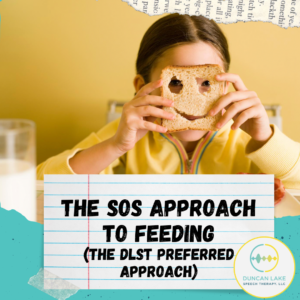by Hannah Blackwell, M.A., CCC-SLP
Speech-Language Pathologist
Duncan Lake Speech Therapy, LLC
While eating, at face value, often appears to be a simple process, it is actually quite complex. For those with feeding disorders, we often observe behaviors as a result of the complexities involved in eating. Therapeutic intervention can help to identify the root cause of feeding issues and help individuals build the necessary skills for eating. There are a couple approaches to feeding therapy, but I (Hannah) have been trained in the Sequential Oral Sensory (SOS) approach to feeding in therapy.
This approach uses systematic desensitization when targeting the skill deficits, particularly sensory and oral-motor difficulties, that are impacting someone’s ability to eat. Treatment uses typical developmental steps, stages, and skills associated with feeding as a blueprint to create a hierarchy of skills and behaviors which are implemented through therapy. Working through this hierarchy, we can help children explore and progress toward eating various textures at a comfortable rate for them.

How does the SOS Approach to Feeding Work?
As I mentioned earlier, eating is a complex process. Most people think about it as 2 steps: pick up the food and put it in your mouth. In reality, there are many steps to eating!
The Core 6 Steps:
- Visually tolerate food (look at it)
- Interact with the food using a utensil
- Smell the food
- Touch food with fingers, hands, body, and mouth
- Taste food (starting outside the mouth with just the tongue tip and working inward)
- Chew and swallow the food
Each of these steps include additional steps, equating to a total of 32 steps! The number of steps may be even more for children with pediatric feeding disorder. Feeding therapy can help parents identify why behaviors around food are occurring, teach children how to move through the steps to eating, teach parents and children strategies for interacting with food, and allow for children to develop a positive relationship with food.
The SOS approach is rooted in the idea that quality interactions with new foods are more important than quantity of new foods eaten. By working in small steps through food hierarchies using systematic desensitization, children can build strong, positive associations with food. This will lead to increased volume of foods eaten, even if we don’t see it right away.
How is Systematic Desensitization Used?
Systematic desensitization is one of the core tenets of the SOS approach. Traditionally, systematic desensitization is used in psychology by teaching patients relaxation responses to compete with anxiety during exposure to a gradual hierarchy of anxiety producing stimuli in order to help them overcome their fears. During this process, the patient is always in control of the exposure and able to return to a safe state with the help of the therapist at any time.
The SOS approach uses this technique to help children work through the many steps to eating. The competing relaxation response is the act of playing with food and the positive, fun, social reinforcement present in the feeding therapy room. If a child can’t tolerate a level of exposure, the therapist picks up on their signal (demeanor change, body language, verbalizations) and drops back to a safe level of interaction. This allows the child to relax. Children are in charge of themselves and their interaction with food, and are able to decide when they can no longer move up the steps to eating hierarchy.

Plates from an actual feeding therapy session with Ms. Hannah!
Who is Feeding Therapy for?
Any child who is experiencing severe feeding difficulties may benefit from feeding therapy. After an evaluation, if the therapist determines that your child is a picky eater (typical developmental stage) all you may need are strategies to incorporate at home. Other times, therapist may determine your child is a problem feeder. Then, they may request coming in for feeding therapy as well as incorporating strategies at home. Problem feeders exhibit many of the following behaviors:
- Difficulty staying seated at the table
- Brand-specific food preferences and/or likes food prepared the same way
- Eats less than 20 different foods
- Stressful mealtimes for the child and/or the family
- Difficulty eating in a variety of settings
- Tends to cry/fall apart when new foods are presented
- Refuse to eat entire food groups or category of texture
- Eat separate meals from the family
- Stop eating a food they previously liked
- Difficulty exploring foods with their eyes, nose, hands, and tongue
If you have concerns about your child’s eating and/or if they exhibit behaviors in response to food, a speech therapist or occupational therapist trained in the SOS Approach to Feeding can help. An evaluation will allow the therapist to identify what is causing these behaviors and determine where your child’s difficulties lie. Duncan Lake Speech Therapy offers speech therapy services in many areas, including feeding. If you have any questions or would like to learn more, don’t hesitate to reach out via phone or email!
References
SOS Approach to Feeding developed by Dr. Kay Toomey: SOS Approach to Feeding | Feeding Disorders in Children



Recent Comments